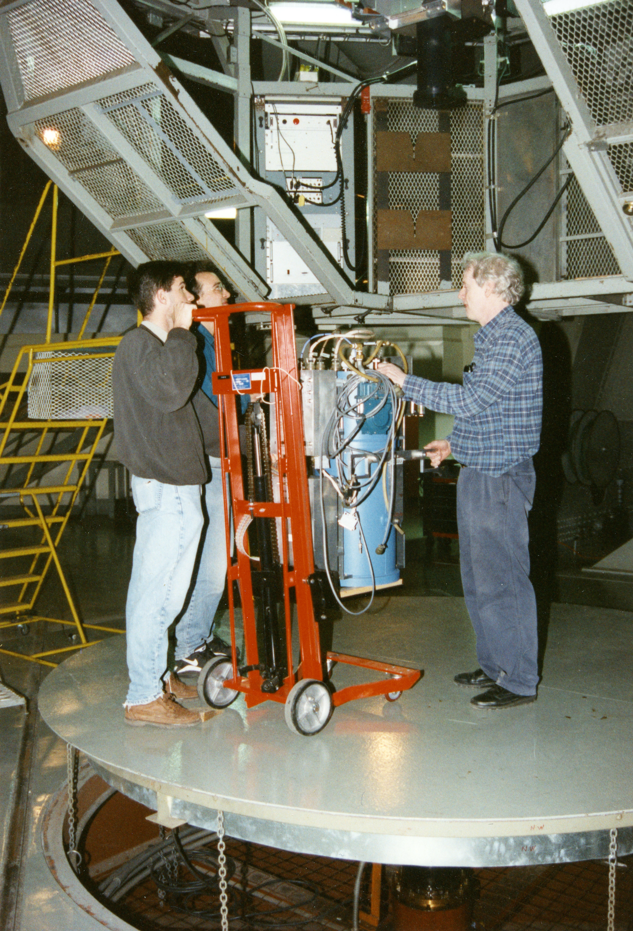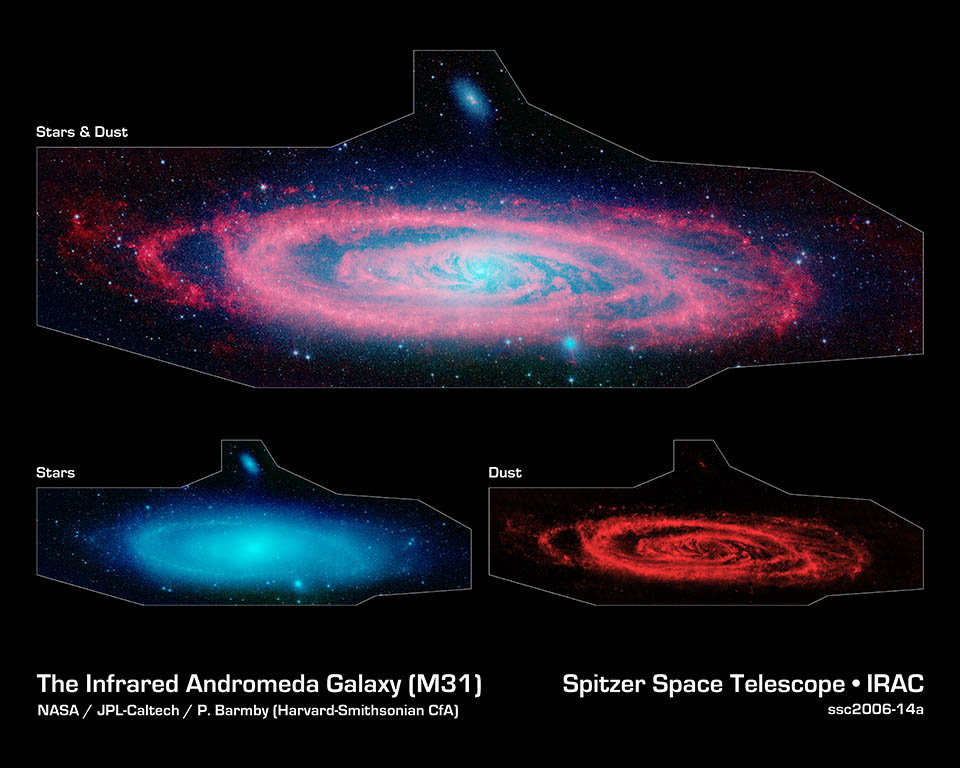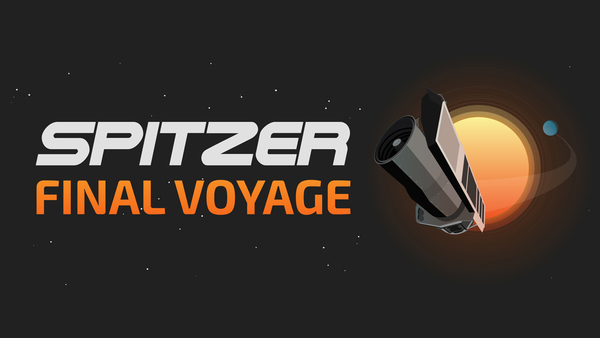
By Matt Ashby | September 18th, 2019
Thinking back on it now, so close to the end of Spitzer's mission, it would be pretty hard to understate the impact it's had on my life. Spitzer influenced me as a graduate student, as a member of the Spitzer team, and as a scientist.
In the 1990s, Spitzer (it was SIRTF then) supported my education. I was a young and inexperienced Cornell graduate student working for Jim Houck, the PI of the InfraRed Spectrograph (IRS). One of the projects Jim advised me on was SpectroCam-10 (and I should be clear that my role was really secondary to that of other people in the Cornell infrared group, like John Miles). Words are inadequate to convey the excitement of watching the sun set over the Pacific from the catwalk of the Hale telescope on a clear evening, knowing we'd spend the next night observing with a brand-new, state-of-the-art instrument. And it certainly didn't put a damper on things to know our efforts were helping pave the way for Spitzer. I mean, how lucky was I to be here!

Getting ready to unlock the secrets of the universe. Shown here are Jim Houck (on the right), with Jeffrey van Cleve and John Wilson, attaching SpectroCam-10, a testbed instrument for Spitzer's InfraRed Spectrograph, to the 200-inch Hale Telescope at Palomar. Photo courtesy of Tom Soifer
My thesis didn't involve SpectroCam-10. Instead, it dealt with imaging and photometry of infrared-luminous galaxies, which was terrific, because it meant I returned to Palomar often to observe these objects with other instruments. More to the point, it meant I had many opportunities to learn from my advisor by watching him in action. Even now, I remain grateful that despite my appalling ignorance, Jim was so generous with his time. He pushed back on the countless demands for his attention to join me for my observing runs, making sure I had usable data for my thesis. All those shared nights in control rooms taught me the Houck way of handling problems (by breaking them down into small pieces). Jim was a master at solving problems.
That may not seem like a super-big whoop, but those high-stakes problem-solving sessions under pressure (counting down the minutes till dawn) really helped me grow as a scientist. Both of those gifts -- the problem-solving practice and the privilege of observing at Palomar -- turned out to be excellent preparation for my later roles in Spitzer.
In 1998 I joined the Infrared Array Camera (IRAC) team at the Center for Astrophysics in Cambridge. Another stroke of good fortune! My duties included helping with the integration and test procedures to make sure IRAC played well with the rest of the observatory. To make *that* happen, I spent a lot of time on the road: at Goddard Space Flight Center (GSFC) in Maryland testing the camera where it was built and with the dedicated engineers who built it, then at Ball Aerospace in Boulder (my hometown) where IRAC was integrated with the Cryogenic Telescope Assembly (CTA), then at Lockheed in Sunnyvale where we made sure the spacecraft worked well with the CTA. I had to learn a lot of acronyms. I also spent about one week in four away from home for several years.
That was a tremendous adventure, and things didn't always go smoothly. For example, at Lockheed somebody discovered a leak in the nozzles that vent molecular nitrogen (N2) for momentum dumps. The leak was tiny, but a deadly serious problem nonetheless because the N2 was needed to prevent solar photon pressure from spinning up the observatory, turning it inexorably into an expensive piece of space debris. At one point during the troubleshooting, I--a mere scientist, remember--was invited in to Lockheed's clean room to view the spacecraft up close, partially unwrapped and disassembled to expose the nozzles that needed work. It was about the size of a comfy living room chair.
I had two thoughts.The first was: "Look at that! We're going to send THIS THING millions of miles out into space!" (Because there was no real doubt the nozzles would get fixed.) The second was: "Step back Matt. You could sneeze on, or even worse, bump into that. You'll knock it over and be remembered forever as THAT guy."
I stepped back.
You can imagine the anxiety we all felt later, when it came time to launch Spitzer. Would it reach orbit? Would it work once it got there? (Selfish corollary: Would I have a job next week?) I carried quite a bit of excitement mingled with worry when my family and I went to the jetty on the Banana River across from Cape Canaveral on launch night. From there, we joined Judy Piper, Peter Eisenhardt, many other Spitzer people (outnumbered by the nighttime anglers) to enjoy the clear view of the brightly lit, blue and white Delta II heavy rocket sitting on its pad while the launch sequence counted down to zero.
If you've never seen a spacecraft launch, well, I recommend it. I'll never forget my panic trying to wake up my two-year-old son in time to watch Spitzer lift off. But that was unnecessary: it was LOUD! It shook my whole body. And I'll never forget the sight a few moments later when the booster rockets separated downrange over the Atlantic. The moment the boosters spun away and blinked out one by one in the darkness is when I finally let myself start to relax and believe everything was going to work okay.
That was a decade and a half ago, and since then I've been blessed countless times to see new images created with IRAC -- the camera I was privileged to help get into space. What strikes me as most special about this whole experience, apart from the people I've met, are the unexpected things, the scientific surprises. We had no idea when we launched Spitzer it would turn out to be so useful for exoplanet transit science. Nor did we expect IRAC would help find galaxies at redshifts of 7, 8, 9, and even beyond. I'm so grateful to Giovanni Fazio, the IRAC team PI, and all the scientists and engineers who so thoroughly tested IRAC starting way back in the GSFC highbay, whose work allowed the camera to work so much better than we expected. When we were running those hundreds of infrared array heater tests, the scientific surprises were still far in the future.

I am incredibly fortunate to have been connected to the Spitzer mission for so long, first as a graduate student, then as a member of the instrument team, and now as a scientist. It has had a profound impact on my career. Two favorite Spitzer images stand out as especially memorable. The first is Pauline Barmby's IRAC mosaic of Messier 31, the Great Galaxy in Andromeda. Even though M31 is a close neighbor (by some standards, anyway), and we might have thought we understood it well beforehand, IRAC revealed so much structure within it, and so clearly, that had previously been hidden. For a similar reason, my second favorite is the IRAC mosaic of the Milky Way from the GLIMPSE team. The image was stitched together from thousands of short IRAC exposures to make a breathtaking image of the Galaxy. A 20x3-foot enlargement of a portion of it is just down the hall from my office where I can enjoy it several times every day.

 Space Was Her Second Act: As Spitzer Takes Its Final Bow, Astronomer and Actress Aomawa Shields Thanks Spitzer For Her Big Break.
Space Was Her Second Act: As Spitzer Takes Its Final Bow, Astronomer and Actress Aomawa Shields Thanks Spitzer For Her Big Break.
 NASA’s Spitzer’s Space Telescope: Shaping Scientific Careers of Researchers and Future Space Telescopes
NASA’s Spitzer’s Space Telescope: Shaping Scientific Careers of Researchers and Future Space Telescopes



